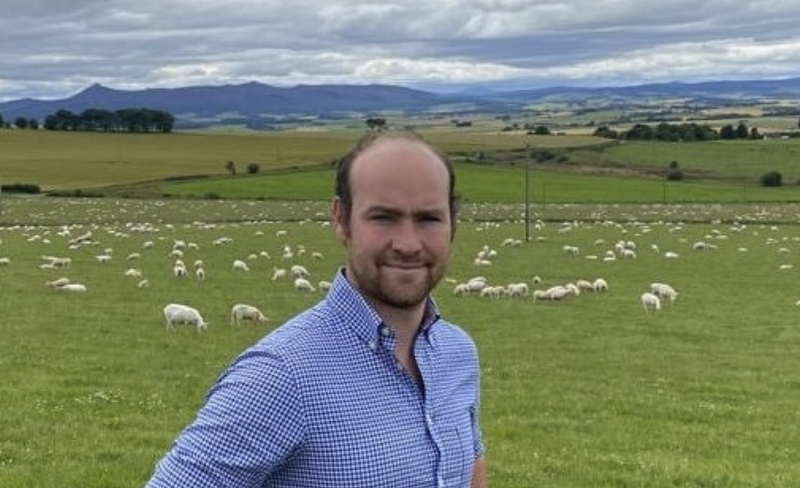Maximising Production from Forage at East Fingask
30 March 2024This article originally appeared on the Farming For A Better Climate website
Michael Ritch farms at East Fingask, Old Meldrum in the North East of Scotland, he farms alongside his father and is the third generation to farm the land.
The business operates a large mixed farming system, extending over 506 hectares of land. The business grows a range of winter and spring arable crops, runs a herd of 170 suckler cows and a flock of 1,050 ewes.
The Flock
Michael introduced the sheep enterprise back in 2015, following the purchase of land near the unit that is not suitable for arable production. The flock has been built with the aim to maximise production from forage, whilst producing a low input marketable prime lamb suitable for market requirements.
The system is outdoor based, lambing in May. Lambing later in the year, there is no requirement for concentrate feeding for the ewes pre lambing. The flock includes 1,050 head of sheep, of which 250 are hoggs which are lambed. The scanning percentage for the ewes is 185%, while the hoggs are 90%. Losses are 15% from scanning to marking. The ewe of choice is a hybrid including Texel, Charolais and Lleyn genetics, she is a functional ewe giving the maternal lambing ease and milk, while also carrying terminal genetics for growth rates and conformation. The average mature weight of the ewes is 70kg. A hybrid tup is used over the flock, allowing home bred replacements to be retained and the remaining lambs marketed as prime lambs. These progeny are finished on grass and forage crops, with no concentrate feeding being used.
How is the sheep enterprise managed to reduce emissions?
The sheep enterprise at East Fingask has been designed to maximise production from forage, reducing reliance on purchased concentrate feeding and importing other feed sources to the farm. Optimising flock output is also important. Both of these aspects play a large part in mitigating emissions of green house gases (GHG) from the enterprise. Here we take a look at each aspect in more detail.
Production from Forage
Grazing sheep on grassland on a rotational basis offers economical benefits to the producer, but also offers benefits to the environment. Grassland can be an important carbon store. When sheep are grazing fields on a set stocked basis, they can overgraze areas of the field which leads to soil carbon loss. In a rotational system, the sheep are moved regularly which rests the grass to avoid overgrazing and promotes root development. The grass benefits in that the residual allows for energy for the plant to continue growing. The quality of this rotational grass is higher than set stocked pasture, helping the animal grow in an efficient manner, with all nutritional needs being sourced from natural grass.
In this system the stocking rate can be increased, Michael is currently running 20 ewes (plus lambs) per acre on this system.
For this system to work to its best ability the soil fertility must be correct, and Michael is currently working to increase the pH levels of all of his soil to pH 6.2 and ensuring P & K levels in the soil are optimum.
Weaning the lambs is triggered by the condition of the ewe, the performance of the lamb and the timing of the second cut silage. At weaning the lambs are drafted and all lambs >28kg are grazed on the silage aftermath. Lambs <28kg are grazed on the forage rape, which is established after the land is fallow for an Ecological Focus Area (EFA), by simply discing the fallow and broadcasting the seed on to the ground in the middle of July.
The grass on the unit is rested over the winter period and all ewes are grazed on fodder beet or swedes from January through to April. This crop allows for the ewes to have access to excellent nutrition throughout the winter, when grass growth is limited, limiting the use of purchased concentrates and conserved forage.
Production from forage – key elements include:
- Stocking rate
- Roatational grazing
- Lime, lime, lime
- Use of silage aftermath for lambs
- Forage rape for lambs
- Fodder beet for winter
Efficiency Tips
Having an efficient system is a further way to aid in mitigating emissions from livestock farming. The business has grown the ewe enterprise quickly and has implemented many changes over the years, but the main efficiency factors being practiced include the following elements;
- Weaning at 90 days – aiding ewe condition for tupping, boosting lamb performance and allocating the best of grass to priority stock.
- Record at birth – lambs are tagged and recorded to observe growth and to aid with choosing unassisted births for replacements from the flock along with other information such as foot health
- 3 weeks tupping – tups are only in with ewes for a three week period
- Lamb in small groups – this has been introduced to prevent miss mothering with groups of only 50-60 ewes, this will be reduced to groups of 30 next year. This also benefits in bad weather given there is poor shelter on the farm.
- Tupping ewe lambs – speeding up genetic progress of the flock and efficiency of the ewes
- Condition scoring and separating hoggs and lean ewes – offering the best of grass at weaning to increase production.
Download this case study
Sign up to the FAS newsletter
Receive updates on news, events and publications from Scotland’s Farm Advisory Service

